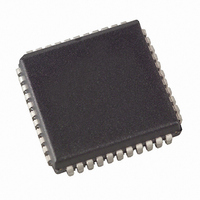AT89S53-24JI Atmel, AT89S53-24JI Datasheet - Page 13

AT89S53-24JI
Manufacturer Part Number
AT89S53-24JI
Description
MICRO CONTROLLER
Manufacturer
Atmel
Series
89Sr
Datasheet
1.AT89S53-24JI.pdf
(35 pages)
Specifications of AT89S53-24JI
Core Processor
8051
Core Size
8-Bit
Speed
24MHz
Connectivity
SPI, UART/USART
Peripherals
WDT
Number Of I /o
32
Program Memory Size
12KB (12K x 8)
Program Memory Type
FLASH
Ram Size
256 x 8
Voltage - Supply (vcc/vdd)
4 V ~ 6 V
Oscillator Type
Internal
Operating Temperature
-40°C ~ 85°C
Package / Case
44-PLCC
Data Bus Width
8 bit
Data Ram Size
256 B
Interface Type
SPI, UART
Maximum Clock Frequency
24 MHz
Number Of Programmable I/os
32
Number Of Timers
3 x 16 bit
Operating Supply Voltage
4 V to 6 V
Maximum Operating Temperature
+ 85 C
Mounting Style
SMD/SMT
Minimum Operating Temperature
- 40 C
Lead Free Status / RoHS Status
Contains lead / RoHS non-compliant
Eeprom Size
-
Data Converters
-
Lead Free Status / Rohs Status
No
Other names
Q1036833
Available stocks
Company
Part Number
Manufacturer
Quantity
Price
Company:
Part Number:
AT89S53-24JI
Manufacturer:
ATM
Quantity:
620
Company:
Part Number:
AT89S53-24JI
Manufacturer:
ATM
Quantity:
620
Part Number:
AT89S53-24JI
Manufacturer:
ATMEL/爱特梅尔
Quantity:
20 000
Baud Rate Generator
Timer 2 is selected as the baud rate generator by setting
TCLK and/or RCLK in T2CON (Table 2). Note that the baud
rates for transmit and receive can be different if Timer 2 is
used for the receiver or transmitter and Timer 1 is used for
the other function. Setting RCLK and/or TCLK puts Timer 2
into its baud rate generator mode, as shown in Figure 4.
The baud rate generator mode is similar to the auto-reload
mode, in that a rollover in TH2 causes the Timer 2 registers
to be reloaded with the 16-bit value in registers RCAP2H
and RCAP2L, which are preset by software.
The baud rates in Modes 1 and 3 are determined by Timer
2’s overflow rate according to the following equation.
The Timer can be configured for either timer or counter
operation. In most applications, it is configured for timer
operation (CP/T2 = 0). The timer operation is different for
Timer 2 when it is used as a baud rate generator. Normally,
as a timer, it increments every machine cycle (at 1/12 the
oscillator frequency). As a baud rate generator, however, it
increments every state time (at 1/2 the oscillator fre-
quency). The baud rate formula is given below.
where (RCAP2H, RCAP2L) is the content of RCAP2H and
RCAP2L taken as a 16-bit unsigned integer.
Timer 2 as a baud rate generator is shown in Figure 4. This
figure is valid only if RCLK or TCLK = 1 in T2CON. Note
that a rollover in TH2 does not set TF2 and will not gener-
ate an interrupt. Note too, that if EXEN2 is set, a 1-to-0
transition in T2EX will set EXF2 but will not cause a reload
from (RCAP2H, RCAP2L) to (TH2, TL2). Thus when Timer
0787E–MICRO–3/06
Modes 1 and 3 Baud Rates
Modes 1 and 3
-------------------------------------- -
Baud Rate
=
--------------------------------------------------------------------------------------------- -
32
×
[
65536
Oscillator Frequency
=
–
Timer 2 Overflow Rate
----------------------------------------------------------- -
(
RCAP2H,RCAP2L
16
)
]
2 is in use as a baud rate generator, T2EX can be used as
an extra external interrupt.
Note that when Timer 2 is running (TR2 = 1) as a timer in
the baud rate generator mode, TH2 or TL2 should not be
read from or written to. Under these conditions, the Timer is
incremented every state time, and the results of a read or
write may not be accurate. The RCAP2 registers may be
read but should not be written to, because a write might
overlap a reload and cause write and/or reload errors. The
timer should be turned off (clear TR2) before accessing the
Timer 2 or RCAP2 registers.
Programmable Clock Out
A 50% duty cycle clock can be programmed to come out on
P1.0, as shown in Figure 5. This pin, besides being a regu-
l a r I / 0 p i n , h a s t w o a l t e r n a t e f u n c t i o n s . I t c a n b e
programmed to input the external clock for Timer/Counter 2
or to output a 50% duty cycle clock ranging from 61 Hz to 4
MHz at a 16 MHz operating frequency.
To configure the Timer/Counter 2 as a clock generator, bit
C/T2 (T2CON.1) must be cleared and bit T2OE (T2MOD.1)
must be set. Bit TR2 (T2CON.2) starts and stops the timer.
The clock-out frequency depends on the oscillator fre-
quency and the reload value of Timer 2 capture registers
(RCAP2H, RCAP2L), as shown in the following equation.
In the clock-out mode, Timer 2 rollovers will not generate
an interrupt. This behavior is similar to when Timer 2 is
used as a baud-rate generator. It is possible to use Timer 2
as a baud-rate generator and a clock generator simulta-
neously. Note, however, that the baud-rate and clock-out
frequencies cannot be determined independently from one
another since they both use RCAP2H and RCAP2L.
Clock-Out Frequency
=
------------------------------------------------------------------------------------------ -
4
×
[
65536
Oscillator Frequency
–
(
RCAP2H,RCAP2L
AT89S53
13
)
]
















